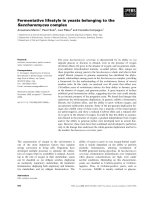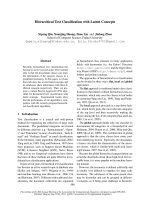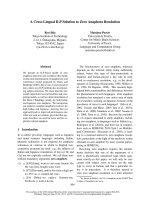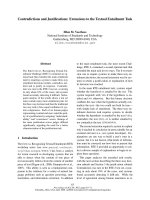Báo cáo khoa học: "Entailment-based Text Exploration with Application to the Health-care Domain" pot
Bạn đang xem bản rút gọn của tài liệu. Xem và tải ngay bản đầy đủ của tài liệu tại đây (922.45 KB, 6 trang )
Proceedings of the 50th Annual Meeting of the Association for Computational Linguistics, pages 79–84,
Jeju, Republic of Korea, 8-14 July 2012.
c
2012 Association for Computational Linguistics
Entailment-based Text Exploration
with Application to the Health-care Domain
Meni Adler
Bar Ilan University
Ramat Gan, Israel
Jonathan Berant
Tel Aviv University
Tel Aviv, Israel
Ido Dagan
Bar Ilan University
Ramat Gan, Israel
Abstract
We present a novel text exploration model,
which extends the scope of state-of-the-art
technologies by moving from standard con-
cept-based exploration to statement-based ex-
ploration. The proposed scheme utilizes the
textual entailment relation between statements
as the basis of the exploration process. A user
of our system can explore the result space of
a query by drilling down/up from one state-
ment to another, according to entailment re-
lations specified by an entailment graph and
an optional concept taxonomy. As a promi-
nent use case, we apply our exploration sys-
tem and illustrate its benefit on the health-care
domain. To the best of our knowledge this is
the first implementation of an exploration sys-
tem at the statement level that is based on the
textual entailment relation.
1 Introduction
Finding information in a large body of text is be-
coming increasingly more difficult. Standard search
engines output a set of documents for a given query,
but do not allow any exploration of the thematic
structure in the retrieved information. Thus, the need
for tools that allow to effectively sift through a target
set of documents is becoming ever more important.
Faceted search (Stoica and Hearst, 2007; K
¨
aki,
2005) supports a better understanding of a target do-
main, by allowing exploration of data according to
multiple views or facets. For example, given a set of
documents on Nobel Prize laureates we might have
different facets corresponding to the laureate’s na-
tionality, the year when the prize was awarded, the
field in which it was awarded, etc. However, this
type of exploration is still severely limited insofar
that it only allows exploration by topic rather than
content. Put differently, we can only explore accord-
ing to what a document is about rather than what
a document actually says. For instance, the facets
for the query ‘asthma’ in the faceted search engine
Yippy include the concepts allergy and children, but
do not specify what are the exact relations between
these concepts and the query (e.g., allergy causes
asthma, and children suffer from asthma).
Berant et al. (2010) proposed an exploration
scheme that focuses on relations between concepts,
which are derived from a graph describing textual
entailment relations between propositions. In their
setting a proposition consists of a predicate with two
arguments that are possibly replaced by variables,
such as ‘X control asthma’. A graph that specifies
an entailment relation ‘X control asthma → X af-
fect asthma’ can help a user, who is browsing doc-
uments dealing with substances that affect asthma,
drill down and explore only substances that control
asthma. This type of exploration can be viewed as
an extension of faceted search, where the new facet
concentrates on the actual statements expressed in
the texts.
In this paper we follow Berant et al.’s proposal,
and present a novel entailment-based text explo-
ration system, which we applied to the health-care
domain. A user of this system can explore the re-
sult space of her query, by drilling down/up from
one proposition to another, according to a set of en-
tailment relations described by an entailment graph.
In Figure 1, for example, the user looks for ‘things’
79
Figure 1: Exploring asthma results.
that affect asthma. She invokes an ‘asthma’ query
and starts drilling down the entailment graph to ‘X
control asthma’ (left column). In order to exam-
ine the arguments of a selected proposition, the user
may drill down/up a concept taxonomy that classi-
fies terms that occur as arguments. The user in Fig-
ure 1, for instance, drills down the concept taxon-
omy (middle column), in order to focus on Hor-
mones that control asthma, such as ‘prednisone’
(right column). Each drill down/up induces a subset
of the documents that correspond to the aforemen-
tioned selections. The retrieved document in Fig-
ure 1 (bottom) is highlighted by the relevant propo-
sition, which clearly states that prednisone is often
given to treat asthma (and indeed in the entailment
graph ‘X treat asthma’ entails ‘X control asthma’).
Our system is built over a corpus of documents,
a set of propositions extracted from the documents,
an entailment graph describing entailment relations
between propositions, and, optionally, a concept hi-
erarchy. The system implementation for the health-
care domain, for instance, is based on a web-crawled
health-care corpus, the propositions automatically
extracted from the corpus, entailment graphs bor-
rowed from Berant et al. (2010), and the UMLS
1
taxonomy. To the best of our knowledge this is the
first implementation of an exploration system, at the
proposition level, based on the textual entailment re-
lation.
2 Background
2.1 Exploratory Search
Exploratory search addresses the need of users to
quickly identify the important pieces of information
in a target set of documents. In exploratory search,
users are presented with a result set and a set of ex-
ploratory facets, which are proposals for refinements
of the query that can lead to more focused sets of
documents. Each facet corresponds to a clustering
of the current result set, focused on a more specific
topic than the current query. The user proceeds in
the exploration of the document set by selecting spe-
cific documents (to read them) or by selecting spe-
cific facets, to refine the result set.
1
/>80
Early exploration technologies were based on a
single hierarchical conceptual clustering of infor-
mation (Hofmann, 1999), enabling the user to drill
up and down the concept hierarchies. Hierarchi-
cal faceted meta-data (Stoica and Hearst, 2007), or
faceted search, proposed more sophisticated explo-
ration possibilities by providing multiple facets and
a hierarchy per facet or dimension of the domain.
These types of exploration techniques were found to
be useful for effective access of information (K
¨
aki,
2005).
In this work, we suggest proposition-based ex-
ploration as an extension to concept-based explo-
ration. Our intuition is that text exploration can
profit greatly from representing information not only
at the level of individual concepts, but also at the
propositional level, where the relations that link con-
cepts to one another are represented effectively in a
hierarchical entailment graph.
2.2 Entailment Graph
Recognizing Textual Entailment (RTE) is the task
of deciding, given two text fragments, whether the
meaning of one text can be inferred from another
(Dagan et al., 2009). For example, ‘Levalbuterol
is used to control various kinds of asthma’ entails
‘Levalbuterol affects asthma’. In this paper, we use
the notion of proposition to denote a specific type
of text fragments, composed of a predicate with two
arguments (e.g., Levalbuterol control asthma).
Textual entailment systems are often based on en-
tailment rules which specify a directional inference
relation between two fragments. In this work, we
focus on leveraging a common type of entailment
rules, in which the left-hand-side of the rule (LHS)
and the right-hand-side of the rule (RHS) are propo-
sitional templates - a proposition, where one or both
of the arguments are replaced by a variable, e.g., ‘X
control asthma → X affect asthma’.
The entailment relation between propositional
templates of a given corpus can be represented by an
entailment graph (Berant et al., 2010) (see Figure 2,
top). The nodes of an entailment graph correspond
to propositional templates, and its edges correspond
to entailment relations (rules) between them. Entail-
ment graph representation is somewhat analogous to
the formation of ontological relations between con-
cepts of a given domain, where in our case the nodes
correspond to propositional templates rather than to
concepts.
3 Exploration Model
In this section we extend the scope of state-of-the-
art exploration technologies by moving from stan-
dard concept-based exploration to proposition-based
exploration, or equivalently, statement-based explo-
ration. In our model, it is the entailment relation
between propositional templates which determines
the granularity of the viewed information space. We
first describe the inputs to the system and then detail
our proposed exploration scheme.
3.1 System Inputs
Corpus A collection of documents, which form
the search space of the system.
Extracted Propositions A set of propositions, ex-
tracted from the corpus document. The propositions
are usually produced by an extraction method, such
as TextRunner (Banko et al., 2007) or ReVerb (Fader
et al., 2011). In order to support the exploration
process, the documents are indexed by the proposi-
tional templates and argument terms of the extracted
propositions.
Entailment graph for predicates The nodes of
the entailment graph are propositional templates,
where edges indicate entailment relations between
templates (Section 2.2). In order to avoid circular-
ity in the exploration process, the graph is trans-
formed into a DAG, by merging ‘equivalent’ nodes
that are in the same strong connectivity component
(as suggested by Berant et al. (2010)). In addition,
for clarity and simplicity, edges that can be inferred
by transitivity are omitted from the DAG. Figure 2
illustrates the result of applying this procedure to a
fragment of the entailment graph for ‘asthma’ (i.e.,
for propositional templates with ‘asthma’ as one of
the arguments).
Taxonomy for arguments The optional concept
taxonomy maps terms to one or more pre-defined
concepts, arranged in a hierarchical structure. These
terms may appear in the corpus as arguments of
predicates. Figure 3, for instance, illustrates a sim-
ple medical taxonomy, composed of three concepts
(medical, diseases, drugs) and four terms (cancer,
asthma, aspirin, flexeril).
81
Figure 2: Fragment of the entailment graph for ‘asthma’
(top), and its conversion to a DAG (bottom).
3.2 Exploration Scheme
The objective of the exploration scheme is to support
querying and offer facets for result exploration, in
a visual manner. The following components cover
the various aspects of this objective, given the above
system inputs:
Querying The user enters a search term as a query,
e.g., ‘asthma’. The given term induces a subgraph of
the entailment graph that contains all propositional
templates (graph nodes) with which this term ap-
pears as an argument in the extracted propositions
(see Figure 2). This subgraph is represented as a
DAG, as explained in Section 3.1, where all nodes
that have no parent are defined as the roots of the
DAG. As a starting point, only the roots of the DAG
are displayed to the user. Figure 4 shows the five
roots for the ‘asthma’ query.
Exploration process The user selects one of the
entailment graph nodes (e.g., ‘associate X with
asthma’). At each exploration step, the user can
drill down to a more specific template or drill up to a
Figure 3: Partial medical taxonomy. Ellipses denote con-
cepts, while rectangles denote terms.
Figure 4: The roots of the entailment graph for the
‘asthma’ query.
more general template, by moving along the entail-
ment hierarchy. For example, the user in Figure 5,
expands the root ‘associate X with asthma’, in order
to drill down through ‘X affect asthma’ to ‘X control
Asthma’.
Selecting a propositional template (Figure 1, left
column) displays a concept taxonomy for the argu-
ments that correspond to the variable in the selected
template (Figure 1, middle column). The user can
explore these argument concepts by drilling up and
down the concept taxonomy. For example, in Fig-
ure 1 the user, who selected ‘X control Asthma’,
explores the arguments of this template by drilling
down the taxonomy to the concept ‘Hormone’.
Selecting a concept opens a third column, which
lists the terms mapped to this concept that occurred
as arguments of the selected template. For example,
in Figure 1, the user is examining the list of argu-
ments for the template ‘X control Asthma’, which
are mapped to the concept ‘Hormone’, focusing on
the argument ‘prednisone’.
82
Figure 5: Part of the entailment graph for the ‘asthma’
query, after two exploration steps. This corresponds to
the left column in Figure 1.
Document retrieval At any stage, the list of docu-
ments induced by the current selected template, con-
cept and argument is presented to the user, where
in each document snippet the relevant proposition
components are highlighted. Figure 1 (bottom)
shows such a retrieved document. The highlighted
extraction in the snippet, ‘prednisone treat asthma’,
entails the proposition selected during exploration,
‘prednisone control asthma’.
4 System Architecture
In this section we briefly describe system compo-
nents, as illustrated in the block diagram (Figure 6).
The search service implements full-text and
faceted search, and document indexing. The data
service handles data (e.g., documents) replication
for clients. The entailment service handles the logic
of the entailment relations (for both the entailment
graph and the taxonomy).
The index server applies periodic indexing of new
texts, and the exploration server serves the explo-
ration application on querying, exploration, and data
Figure 6: Block diagram of the exploration system.
access. The exploration application is the front-end
user application for the whole exploration process
described above (Section 3.2).
5 Application to the Health-care Domain
As a prominent use case, we applied our exploration
system to the health-care domain. With the advent
of the internet and social media, patients now have
access to new sources of medical information: con-
sumer health articles, forums, and social networks
(Boulos and Wheeler, 2007). A typical non-expert
health information searcher is uncertain about her
exact questions and is unfamiliar with medical ter-
minology (Trivedi, 2009). Exploring relevant infor-
mation about a given medical issue can be essential
and time-critical.
System implementation For the search service,
we used SolR servlet, where the data service is
built over FTP. The exploration application is im-
plemented as a web application.
Input resources We collected a health-care cor-
pus from the web, which contains more than 2M
sentences and about 50M word tokens. The texts
deal with various aspects of the health care domain:
answers to questions, surveys on diseases, articles
on life-style, etc. We extracted propositions from
the health-care corpus, by applying the method de-
scribed by Berant et al. (2010). The corpus was
parsed, and propositions were extracted from depen-
dency trees according to the method suggested by
Lin and Pantel (2001), where propositions are de-
pendency paths between two arguments of a predi-
83
cate. We filtered out any proposition where one of
the arguments is not a term mapped to a medical
concept in the UMLS taxonomy.
For the entailment graph we used the 23 entail-
ment graphs published by Berant et al.
2
. For the ar-
gument taxonomy we employed UMLS – a database
that maps natural language phrases to over one mil-
lion unique concept identifiers (CUIs) in the health-
care domain. The CUIs are also mapped in UMLS
to a concept taxonomy for the health-care domain.
The web application of our system is
available at: http://132.70.6.148:
8080/exploration
6 Conclusion and Future Work
We presented a novel exploration model, which ex-
tends the scope of state-of-the-art exploration tech-
nologies by moving from standard concept-based
exploration to proposition-based exploration. Our
model combines the textual entailment paradigm
within the exploration process, with application to
the health-care domain. According to our model, it
is the entailment relation between propositions, en-
coded by the entailment graph and the taxonomy,
which leads the user between more specific and
more general statements throughout the search re-
sult space. We believe that employing the entail-
ment relation between propositions, which focuses
on the statements expressed in the documents, can
contribute to the exploration field and improve in-
formation access.
Our current application to the health-care domain
relies on a small set of entailment graphs for 23
medical concepts. Our ongoing research focuses on
the challenging task of learning a larger entailment
graph for the health-care domain. We are also in-
vestigating methods for evaluating the exploration
process (Borlund and Ingwersen, 1997). As noted
by Qu and Furnas (2008), the success of an ex-
ploratory search system does not depend simply on
how many relevant documents will be retrieved for a
given query, but more broadly on how well the sys-
tem helps the user with the exploratory process.
2
/>˜
jonatha6/
homepage_files/resources/HealthcareGraphs.
rar
Acknowledgments
This work was partially supported by the Israel
Ministry of Science and Technology, the PASCAL-
2 Network of Excellence of the European Com-
munity FP7-ICT-2007-1-216886, and the Euro-
pean Communitys Seventh Framework Programme
(FP7/2007-2013) under grant agreement no. 287923
(EXCITEMENT).
References
Michele Banko, Michael J Cafarella, Stephen Soderl,
Matt Broadhead, and Oren Etzioni. 2007. Open in-
formation extraction from the web. In Proceedings of
IJCAI, pages 2670–2676.
Jonathan Berant, Ido Dagan, and Jacob Goldberger.
2010. Global learning of focused entailment graphs.
In Proceedings of ACL, Uppsala, Sweden.
Pia Borlund and Peter Ingwersen. 1997. The develop-
ment of a method for the evaluation of interactive in-
formation retrieval systems. Journal of Documenta-
tion, 53:225–250.
Maged N. Kamel Boulos and Steve Wheeler. 2007. The
emerging web 2.0 social software: an enabling suite of
sociable technologies in health and health care educa-
tion. Health Information & Libraries, 24:2–23.
Ido Dagan, Bill Dolan, Bernardo Magnini, and Dan Roth.
2009. Recognizing textual entailment: Rational, eval-
uation and approaches. Natural Language Engineer-
ing, 15(Special Issue 04):i–xvii.
Anthony Fader, Stephen Soderland, and Oren Etzioni.
2011. Identifying relations for open information ex-
traction. In EMNLP, pages 1535–1545. ACL.
Thomas Hofmann. 1999. The cluster-abstraction model:
Unsupervised learning of topic hierarchies from text
data. In Proceedings of IJCAI, pages 682–687.
Mika K
¨
aki. 2005. Findex: search result categories help
users when document ranking fails. In Proceedings
of SIGCHI, CHI ’05, pages 131–140, New York, NY,
USA. ACM.
Dekang Lin and Patrick Pantel. 2001. Discovery of infer-
ence rules for question answering. Natural Language
Engineering, 7:343–360.
Yan Qu and George W. Furnas. 2008. Model-driven for-
mative evaluation of exploratory search: A study un-
der a sensemaking framework. Inf. Process. Manage.,
44:534–555.
Emilia Stoica and Marti A. Hearst. 2007. Automating
creation of hierarchical faceted metadata structures. In
Proceedings of NAACL HLT.
Mayank Trivedi. 2009. A study of search engines for
health sciences. International Journal of Library and
Information Science, 1(5):69–73.
84









